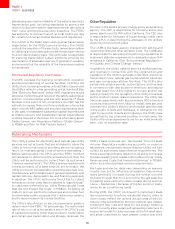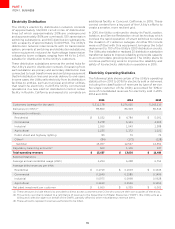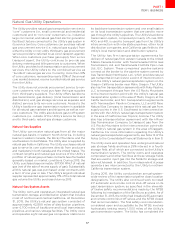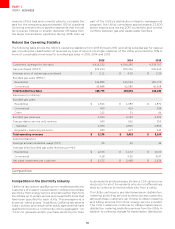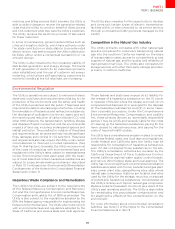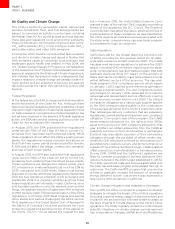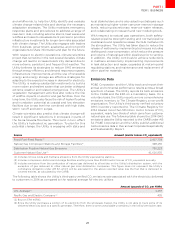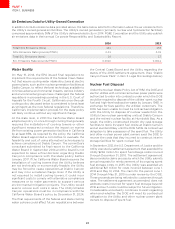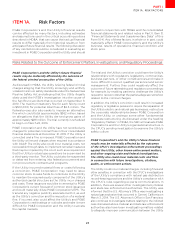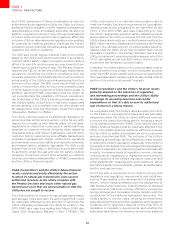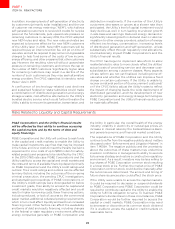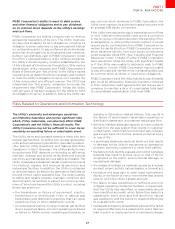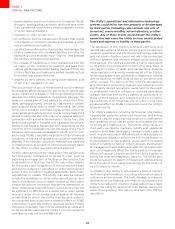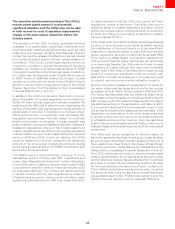PG&E 2015 Annual Report Download - page 27
Download and view the complete annual report
Please find page 27 of the 2015 PG&E annual report below. You can navigate through the pages in the report by either clicking on the pages listed below, or by using the keyword search tool below to find specific information within the annual report.
19
PART I
ITEM1.BUSINESS
metering, and billing services that it provides, the Utility is
able to collect charges to recover the generation-related
costs that the Utility incurred on behalf of direct access
and CCA customers while they were the Utility’s customers.
The Utility remains the electricity provider of last resort
for these customers.
In some circumstances, governmental entities such as
cities and irrigation districts, which have authority under
the state constitution or state statute to provide retail
electric service, may seek to acquire the Utility’s distribution
facilities, either under a consensual transaction or via
eminent domain.
The Utility is also impacted by the increasing viability of
distributed generation and energy storage. The levels
of self-generation of electricity by customers (primarily
solar installations) and the use of customer net energy
metering, which allows self-generating customers to
receive bill credits at the full retail rate, are increasing.
The Utility also competes for the opportunity to develop
and construct certain types of electric transmission
facilities within, or interconnected to, its service territory
through a competitive bidding process managed by the
CAISO.
Competition in the Natural Gas Industry
The Utility primarily competes with other natural gas
pipeline companies for customers transporting natural
gas into the southern California market on the basis
of transportation rates, access to competitively priced
supplies of natural gas, and the quality and reliability of
transportation services. The Utility also competes for
storage services with other third-party storage providers,
primarily in northern California.
Environmental Regulation
The Utility’s operations are subject to extensive federal,
state and local laws and requirements relating to the
protection of the environment and the safety and health
of the Utility’s personnel and the public. These laws and
requirements relate to a broad range of activities, including
the remediation of hazardous and radioactive substances;
the discharge of pollutants into the air, water, and soil;
the reporting and reduction of carbon dioxide (CO
2
) and
other GHG emissions; the transportation, handling, storage
and disposal of spent nuclear fuel; and the environmental
impacts of land use, including endangered species and
habitat protection. The penalties for violation of these laws
and requirements can be severe and may include significant
fines, damages, and criminal or civil sanctions. These laws
and requirements also may require the Utility, under certain
circumstances, to interrupt or curtail operations. (See
Item 1A. Risk Factors.) Generally, the Utility recovers most
of the costs of complying with environmental laws and
regulations in the Utility’s rates, subject to reasonableness
review. Environmental costs associated with the clean-
up of most sites that contain hazardous substances are
subject to a special ratemaking mechanism described
in Note 13: Contingencies—Environmental Remediation
Contingencies, of the Notes to the Consolidated Financial
Statements in Item 8.
Hazardous Waste Compliance and Remediation
The Utility’s facilities are subject to the requirements
of the federal Resource Conservation and Recovery
Act and the Comprehensive Environmental Response,
Compensation and Liability Act of 1980 as amended. The
Utility is also subject to the regulations adopted by the
EPA, the federal agency responsible for implementing the
federal environmental laws. The Utility also must comply
with environmental laws and regulations adopted by the
State of California and various state and local agencies.
These federal and state laws impose strict liability for
the release of a hazardous substance on the (1) owner
or operator of the site where the release occurred, (2) on
companies that disposed of, or arranged for the disposal
of, the hazardous substances, and (3) in some cases,
their corporate successors. Under the Comprehensive
Environmental Response, Compensation and Liability
Act, these persons (known as “potentially responsible
parties”) may be jointly and severally liable for the costs
of cleaning up the hazardous substances, paying for the
harm caused to natural resources, and paying for the
costs of required health studies.
The Utility has a comprehensive program in place to comply
with these federal, state, and local laws and regulations.
Under federal and California laws, the Utility may be
responsible for remediation of hazardous substances
even if it did not deposit those substances on the site.
The Utility’s remediation activities are overseen by the
California Department of Toxic Substances Control,
several California regional water quality control boards,
and various other federal, state, and local agencies. The
Utility has incurred significant environmental remediation
liabilities associated with former manufactured gas plant
sites, power plant sites, gas gathering sites, sites where
natural gas compressor stations are located, and sites
used by the Utility for the storage, recycling, or disposal
of potentially hazardous substances. Groundwater at
the Utility’s Hinkley and Topock natural gas compressor
stations contains hexavalent chromium as a result of the
Utility’s past operating practices. The Utility is responsible
for remediating this groundwater contamination and
for abating the eects of the contamination on the
environment.
For more information about environmental remediation
liabilities, see Note 13 of the Notes to the Consolidated
Financial Statements in Item 8.



